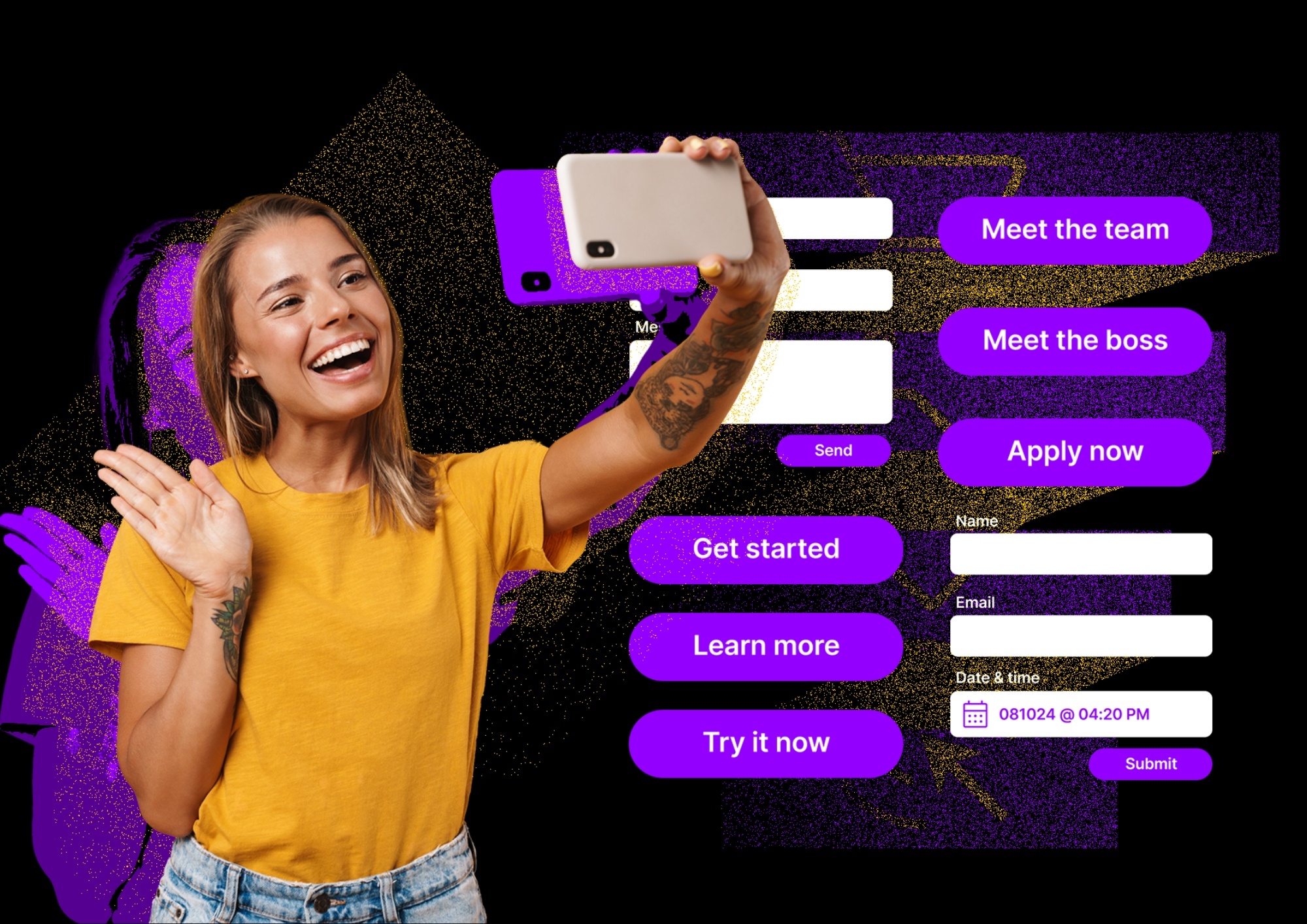Higher engagement is great for your website’s SEO, indicating to the search engines that your content is valuable to the users. This results in improved overall search rankings as well. Moreover, you have to ensure that the bounce rate is low, the session duration is high, and other engagement metrics showcase positive data!
And in an online world where attention is the main currency, you’re faced with the challenge of capturing audience attention while competing with thousands of other brands.
So, how do you ensure that your website keeps visitors engaged long enough to convert to prospective customers? This is what we’ll discuss in this post, so stay tuned!
The Psychology Behind Website Engagement
When you’re targeting an online audience, you’ll have to play with certain psychological factors to draw them to your website. Here are a few important ones:
- First Impressions: It’s said that “First impression is often the last impression”, and this stands true for the online audience. A smooth, clean web interface with attractive designs will engage the audience in an instant. However, if the website looks outdated, they’ll leave immediately.
- Storytelling: Your website should tell a story that’s relatable enough to the audience to form an emotional connection. It could be a play on childhood nostalgia, office culture, or a combination of multiple stories. As long as you can make them relate to what you’re offering, you’re golden!
- Scannability: This works in tandem with the First Impressions point, as visitors want clean content that’s easy to read and understand. Long paragraphs on your website are a strict no!
- Offers: People love a good bargain. If you’re offering incentives and rewards with certain products, showcase them upfront on your homepage. Also, showcase the limited time period before the offer expires. This will create a sense of FOMO (Fear of Missing Out), compelling the visitor to purchase the product.
Reciprocation: All the good stuff for visitors shouldn’t be kept behind paywalls! Provide a few freebies, like a free demo, guides, etc. that the user can access without paying anything. This shows that you believe in giving value to the user!
Key Metrics That Determine Website Engagement
So, you want to understand how engaging your website is? You’ll have to monitor these metrics to gain insights:
-
Bounce Rate: Did you ever open a website and leave immediately after viewing just a single page? If yes, then you’re counted under the bounce rate metric, which is the percentage of users who exited the site after viewing one page. If this metric is high, you’ll have to revamp your website to include more relevant details and better designs. It should also load fast!
-
Average Session Duration: This metric is based on how long a visitor stays on your website in a single visit. A higher average session duration indicates that your website is engaging and provides value to the user.
-
Pages Per Session: This metric is used to measure how many pages a visitor checks on your website in a single session. A lower number of pages per session means that the visitor didn’t find too many relevant details on your website, and that the internal linking is poor.
As a thumb rule, the Bounce Rate of your website should be Low, the Average Session Duration needs to be High, and the Pages Per Session metric should be High.
User Experience for Higher Retention
User experience on your website is crucial for you to have a high engagement on your website. Here are a few aspects to consider when you’re designing or managing your website:
- Responsive Design: The website’s design should be fast and snappy. From scrolling to clicking buttons, there shouldn’t be any delay or lag experienced by the visitor. Plus, it should adapt well to different devices, like a laptop or smartphone.
- Fast Loading Times: As a user, you’d expect a website page to open in 2-5 seconds (the ideal time frame is 2-3 seconds). Any longer, and the user will exit the website. So, keep your website’s loading times quick by optimizing image sizes and formats, reducing the scripts, and implementing caching protocols.
- Clear Navigation: The visitors should find what they’re looking for with immaculate ease. Your website should have a clear, logical flow to the design with clear CTAs.
- Hick’s Law in UX: Hick’s Law states that the more choices a person has, the longer it takes for them to decide. The same is true for website development. So, keep the content clear and categorized based on relevance. Limit their options, and they’ll know exactly what to go for!
Using Visual Hierarchy to Keep Users Engaged
Visual hierarchy allows you to direct the attention of the user to the most important aspects of your website. If done correctly, this directly increases the website’s engagement.
For example, use bold colors and larger fonts for key aspects of your website, like CTAs, offers, etc. Remember to place them strategically too!
You can also improve your website’s readability by contrasting the background color and the font color. This ensures that the messaging stands out. You can also align your website elements based on how users read, such as the F-pattern and Z-pattern. F-pattern is better for websites with more text, while Z-patterns suit websites with less text.
Make use of images as well. These are a great way to draw the user’s attention towards the elements that actively drive engagement and conversion!
Leveraging Social Proof to Build Trust
Social media has changed the marketing game. If your brand isn’t on social media, its growth will be stunted.
So, ensure that you put user reviews from trusted sites or customer testimonial videos on your site to build your brand’s credibility and ensure that users trust your offerings. You can add certifications, number of downloads/purchases, mentions from prominent personalities, and case studies as well.
Oh, and did you know that 92% of customers hesitate to buy products online if there aren’t any customer reviews? Implement social proof into your website today so that your customer base doesn’t become a part of this statistic!
The Power of Interactive Content and Gamification
Interactive videos embedded on your website present a great opportunity for you to boost engagement. These videos can have gamified elements, such as quizzes and branching narratives, to enable the user’s active participation.
This way, your website’s average session duration increases, and you stand out against other brands by offering something novel. If possible, you can add an incentive for the game winners, such as a 5% discount on the product if they get all the answers correct in a quiz!
Personalization: Crafting a Tailored User Experience
A key aspect of a user-friendly web design is personalization. This is often overlooked, and if you’re guilty of this, you’re missing out on maximizing your engagement potential.
Understand your target audience’s preferences based on their survey responses, purchase history, and other such data. Once you do, you’ll know exactly the type of content to put on your website to engage the audience.
You can provide different product recommendations, relevant blog posts, and customized dashboards to engage and entice the user. Another important element is an AI-powered chatbot that can deliver conversational and organic responses to the user’s queries.
How to Optimize CTAs for Better Engagement
The idea with CTAs is simple: keep it short and showcase the value proposition right away. The last thing a user wants to see is a generic CTA, and these are pretty bad at convincing them for conversions.
Let’s take an example.
CTA 1 is “Try the Demo”, and CTA 2 is “Get Your Free Demo Here”.
Which one are you more likely to click? Most of us would answer CTA 2. That’s because the value proposition (Free) is clearly visible, while it’s unclear in CTA 1.
Another trick is to use FOMO, and provide CTAs for limited-time offers or rewards. This creates a sense of urgency for the user, and they’re not willing to miss out on deals.
Of course, you’ll have to brainstorm for relevant CTAs. However, it’ll help immensely in driving sales!
Exit-Intent Strategies to Reduce Drop-Offs
Exit-intent, in simple words, is when the user is about to leave; they showcase the intention to exit the website. So, you can use exit-intent strategies to change their mind and engage them further.
For example, imagine that you’re browsing YouTube and about to exit the video you’re watching. However, when you pause the video, a recommendation pops up that grabs your interest. That’s when you switch to the new video and remain on the YouTube website. This is a form of exit-intent strategy.
To implement this strategy on your website, you can introduce gamification elements. For example, a quiz or poll pops up in the middle of a webpage. This allows the user to engage with the website for longer.
Another great tactic is to redirect them to freebies like guides, PDFs, etc., which are essentially lead magnets. If they choose to sign up, they get these items, and possibly even discounts!
Regardless of what you do, you’ll still have to ensure that your website’s design is functional, fast-loading, and attractive. Otherwise, exit-intent strategies will be less effective.
Conclusion
So, if you want to keep visitors on your website, you’ll have to understand the psychology behind the user, play to their preferences, and optimize your website’s user experience. You can then add social proof, lead magnets, and interactive content to keep their attention.
Out of these, we’d highly recommend interactive videos for engagement. In fact, 93% of consumers believe that interactive videos educate them more about your product than regular, static videos.
So, if you want to start with interactive content, consider Life Inside. Our interactive video platform and dedicated in-house content team can help you collect and create interactive videos, activate them, and automate their distribution on your websites from day one!
Sign up on Life Inside today to experience the maximum engagement potential of your website!
Frequently Asked Questions
1. Why do visitors leave my website quickly?
Your website may either be badly structured, load slowly, or not present relevant information quickly enough. Considering auditing the website’s user experience and design to understand the underlying causes.
2. How can I make my website more interactive?
You can add interactive elements like quizzes, polls, and spinning wheels. However, we’d recommend interactive videos as the best option!
3. What role does social proof play in visitor retention?
Social proof gives new visitors the confidence to purchase your product or services. Customers often relate the most with other customers instead of brands. If they notice that other customers have had a positive experience with your brand, it adds to the brand’s credibility and trust.
4. How can I use videos to reduce bounce rate?
Videos, especially interactive videos, engage the visitor for longer periods as they actively participate in the video’s narrative. This means that visitors stay longer on your website and are less likely to exit after just the first page.
5. How can I measure my website’s engagement success?
A low bounce rate, high average session duration, and high number of pages per session indicate that your website’s engagement rate is positive.




